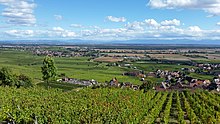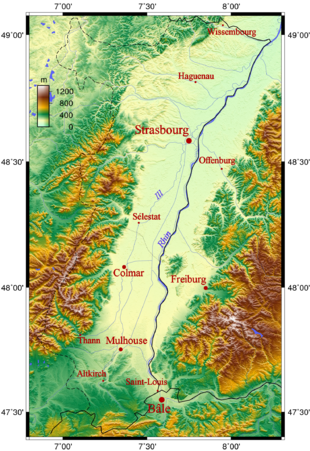Alsace
![]()
The title of this article is ambiguous. For other meanings, see Alsace (disambiguation).
Alsace (in older spelling also Elsaß, Alsatian 's Elsàss, 's Elses, French Alsace [alˈzas]) is a European territorial entity in the Grand Est region in eastern France. It stretches across the southwestern part of the Upper Rhine Plain, reaching to the Lorraine Plateau in the northwest with Crooked Alsace. Alsace borders Germany to the north and east and Switzerland to the south. The capital of the region is Strasbourg.
In terms of landscape, Alsace is usually described as the area between the Vosges and the Rhine. The political borders that define Alsace, on the other hand, have changed several times in the course of its history. Of particular historical importance here are the Duchy of Alsace (7th and 8th centuries), the two Landgraviate of Alsace (12th-17th centuries) within the Holy Roman Empire and the first French province of Alsace (17th-18th centuries).
The current borders of Alsace, which consists of the departments of Bas-Rhin and Haut-Rhin, largely merged in 2021, are based on the demarcations of the French Revolutionary period (departmental borders, Crooked Alsace) and the Peace of Frankfurt in 1871 (Belfort is separated from Alsace).
Since the 17th century, Alsace has changed its political affiliation several times between the Holy Roman Empire or German Empire and France.
Between 1973 and 2015, the two Alsatian departments together formed a separate French administrative region of Alsace (Région Alsace). At 8280 km², it was the smallest region in mainland France in terms of area and had 1,898,533 inhabitants (as of 1 January 2018). As part of the regional mergers, the Grand Est (Greater East) region was created on 1 January 2016, with Strasbourg as its capital. This comprises Alsace, Lorraine and Champagne-Ardenne. As a European territorial entity, the two departments of Alsace were reunited as a single political entity, the "European Territorial Community of Alsace", as of the beginning of 2021.
names
The name Elsass refers to a landscape and political entity already attested in the early Middle Ages. Early Latinized mentions are in pago alsacense (772) and in pago alisacense (774), pure German the name appears as elisazon for the first time in a document of 877. It derives from early High German ali-sāzzo "inhabitant of the other (to add:) Rhine bank" or, elliptically shortened, from early High German ali-land-sāzzo "inhabitant in a foreign country" and is thus a composition of Old High German ali-, eli- "other, foreign", at best land "country" as well as sāzzo "sitter, dweller". Among the "inhabitants of the foreign land", one is most likely to think of the new Frankish settlers who, after the Battle of Zülpich in 496, were settled by the Frankish monarchy on the left bank of the Rhine between Basel and the Palatinate, where they encountered Romans and Alemanni.
Due to the changeable history of Alsace between the Germanic (German) and Romance (French) cultural area, designations based on this arose. Since Alsace was German-speaking and it is still partly today, Welschi or Walschi stands or stood in Alsace for Innerfranzosen in general as well as for the Romansh (Lorraine/French) language enclaves on the eastern side of the Vosges (pays welche) in particular and their language. The Alsatians are also colloquially and pejoratively referred to as Wackes by the German-speaking neighbouring regions, which in Alsatian dialect initially meant country people or unemployed people and partly corresponds to the reverse term Boche.
Geography
Alsace borders Germany (Rhineland-Palatinate to the north, Baden-Württemberg to the east) and Switzerland (cantons of Basel-Stadt, Basel-Landschaft, Solothurn and Jura). To the west, Alsace borders Lorraine, and to the south the Bourgogne-Franche-Comté region.
Today's Alsace has a north-south extension of 190 kilometres, while the west-east extension is only 50 kilometres. In the east, Alsace is bordered by the Rhine, in the west over long stretches by the main ridge of the Vosges. In the north, the Bienwald and Pfälzerwald mark important border areas, in the south the northern edge of the Jura and in the southwest, in the open gateway landscape of the Burgundian Gate, the border, which dates back to 1871, approaches the watershed between the Rhone and Rhine.
The geological history extends from the Precambrian to the Quaternary.
Alsace has the following main natural units:
- Most of it is occupied by the Alsatian Plain (Plaine d'Alsace), which forms the southern part of the Upper Rhine Graben with Breisgau and Ortenau on the German side, and the Petit and Grand Ried on the Alsatian side. It is crossed by the Ill River and is dominated by cereal farming. There are also large forest areas such as the Hagenauer Forst in the north and the Harthwald in the south. In addition to wide plains, undulating to hilly areas occur (for example Kochersberg northwest of Strasbourg, western Sundgau and eastern Burgundian Gate, area between Hagenau Forest and Bienwald).
- To the west, the landscape is dominated by the Vosges, criss-crossed by the wide valleys of the Ill tributaries. Here you will find high pastures (Hautes Chaumes) alternating with forests. The Große Belchen (Grand Ballon) is the highest peak in Alsace and the Vosges, at 1424 m. In France, the areas north of the Zabern Valley are also counted as part of the Vosges (Vosges du Nord), but they form a natural unit with the Palatinate Forest.
- A narrow foothill zone mediates between the plain and the Vosges (analogous to the western edge of the Black Forest). Wine growing is typical for this "Piedmont of the Vosges".
- In the very south, Alsace also has a share of the Jura (Pfirter Jura).

View from Gueberschwihr over the Grand Ried. On the horizon the Black Forest.

Topography of Alsace
Questions and Answers
Q: What is Alsace?
A: Alsace was an administrative region of France that is now part of the Grand Est region. It was located on the eastern border of France, next to Germany and Switzerland.
Q: How many people lived in Alsace before it merged with Champagne-Ardenne and Lorraine in 2014?
A: According to INSEE data, about 1.8 million people lived in Alsace as of 2013.
Q: What were the two departments that made up Alsace?
A: The two departments that made up Alsace were Bas-Rhin and Haut-Rhin.
Q: What city served as the capital for Alsace?
A: Strasbourg was the capital city for Alsace. It was also the largest city in the region.
Q: How did control over Alsace change between France and Germany over time?
A: Control over Alsace changed multiple times between France and Germany throughout history.
Q: How did culture differ between French and German influences in Alsace?
A: The culture in Alsatian differed from French culture due to its closer proximity to Germanic influences such as language, cuisine, music, dress, customs, etc., which were more similar to those found across the Rhine River in Swabia than those found within France itself.
Q: When did Louis XIV annex all of Alsace into one province of France? A: King Louis XIV annexed all of Alsatian into one province of France during the 17th century.
Search within the encyclopedia